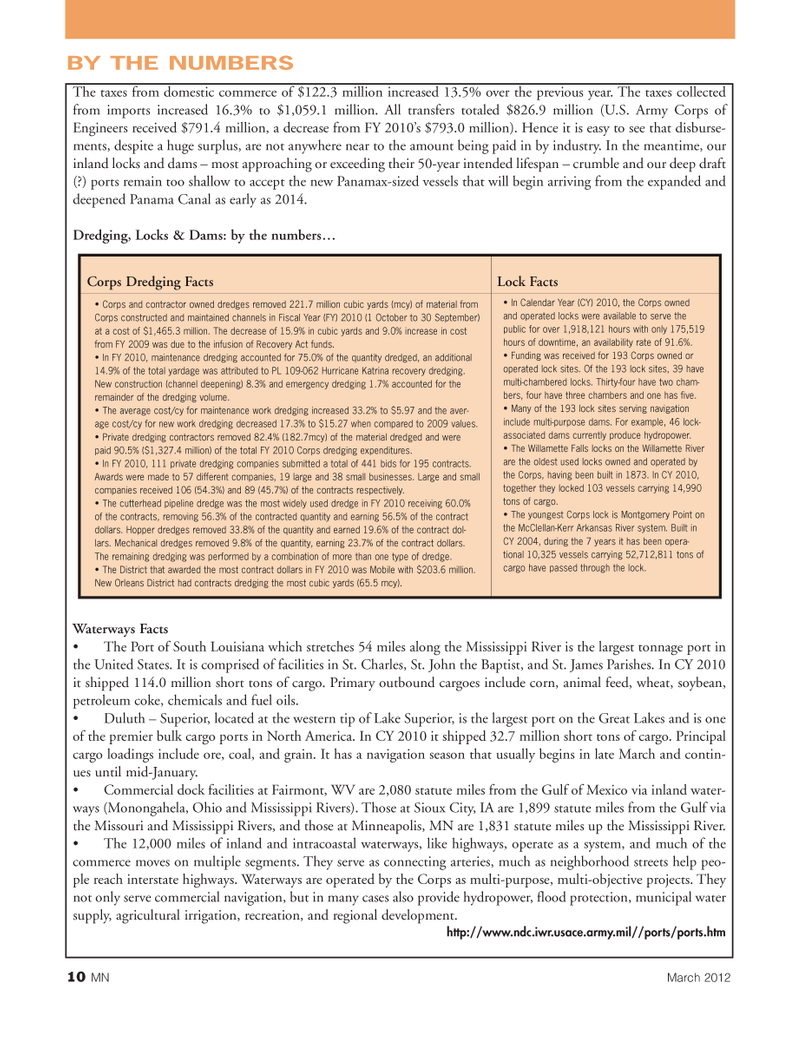
Page 10: of Marine News Magazine (March 2012)
Training & Education
Read this page in Pdf, Flash or Html5 edition of March 2012 Marine News Magazine
10MNMarch 2012 BY THE NUMBERS The taxes from domestic commerce of $122.3 million increased 13.5% over the previous year. The taxes collected from imports increased 16.3% to $1,059.1 million. All transfers totaled $826.9 million (U.S. Army Corps of Engineers received $791.4 million, a decrease from FY 2010?s $793.0 million). Hence it is easy to see that disburse- ments, despite a huge surplus, are not anywhere near to the amount being paid in by industry. In the meantime, our inland locks and dams ? most approaching or exceeding their 50-year intended lifespan ? crumble and our deep draft (?) ports remain too shallow to accept the new Panamax-sized vessels that will begin arriving from the expanded and deepened Panama Canal as early as 2014. Dredging, Locks & Dams: by the numbers? Waterways Facts The Port of South Louisiana which stretches 54 miles along the Mississippi River is the largest tonnage port in the United States. It is comprised of facilities in St. Charles, St. John the Baptist, and St. James Parishes. In CY 2010 it shipped 114.0 million short tons of cargo. Primary outbound cargoes include corn, animal feed, wheat, soybean, petroleum coke, chemicals and fuel oils. Duluth ? Superior, located at the western tip of Lake Superior, is the largest port on the Great Lakes and is one of the premier bulk cargo ports in North America. In CY 2010 it shipped 32.7 million short tons of cargo. Principal cargo loadings include ore, coal, and grain. It has a navigation season that usually begins in late March and contin- ues until mid-January. Commercial dock facilities at Fairmont, WV are 2,080 statute miles from the Gulf of Mexico via inland water- ways (Monongahela, Ohio and Mississippi Rivers). Those at Sioux City, IA are 1,899 statute miles from the Gulf via the Missouri and Mississippi Rivers, and those at Minneapolis, MN are 1,831 statute miles up the Mississippi River. The 12,000 miles of inland and intracoastal waterways, like highways, operate as a system, and much of the commerce moves on multiple segments. They serve as connecting arteries, much as neighborhood streets help peo- ple reach interstate highways. Waterways are operated by the Corps as multi-purpose, multi-objective projects. They not only serve commercial navigation, but in many cases also provide hydropower, flood protection, municipal water supply, agricultural irrigation, recreation, and regional development. http://www.ndc.iwr.usace.army.mil//ports/ports.htm Corps Dredging Facts Lock Facts In Calendar Year (CY) 2010, the Corps owned and operated locks were available to serve the public for over 1,918,121 hours with only 175,519hours of downtime, an availability rate of 91.6%. Funding was received for 193 Corps owned or operated lock sites. Of the 193 lock sites, 39 havemulti-chambered locks. Thirty-four have two cham- bers, four have three chambers and one has five. Many of the 193 lock sites serving navigationinclude multi-purpose dams. For example, 46 lock-associated dams currently produce hydropower. The Willamette Falls locks on the Willamette River are the oldest used locks owned and operated by the Corps, having been built in 1873. In CY 2010,together they locked 103 vessels carrying 14,990tons of cargo. The youngest Corps lock is Montgomery Point onthe McClellan-Kerr Arkansas River system. Built inCY 2004, during the 7 years it has been opera-tional 10,325 vessels carrying 52,712,811 tons ofcargo have passed through the lock. Corps and contractor owned dredges removed 221.7 million cubic yards (mcy) of material from Corps constructed and maintained channels in Fiscal Year (FY) 2010 (1 October to 30 September) at a cost of $1,465.3 million. The decrease of 15.9% in cubic yards and 9.0% increase in cost from FY 2009 was due to the infusion of Recovery Act funds. In FY 2010, maintenance dredging accounted for 75.0% of the quantity dredged, an additional 14.9% of the total yardage was attributed to PL 109-062 Hurricane Katrina recovery dredging. New construction (channel deepening) 8.3% and emergency dredging 1.7% accounted for the remainder of the dredging volume. The average cost/cy for maintenance work dredging increased 33.2% to $5.97 and the aver- age cost/cy for new work dredging decreased 17.3% to $15.27 when compared to 2009 values. Private dredging contractors removed 82.4% (182.7mcy) of the material dredged and were paid 90.5% ($1,327.4 million) of the total FY 2010 Corps dredging expenditures. In FY 2010, 111 private dredging companies submitted a total of 441 bids for 195 contracts. Awards were made to 57 different companies, 19 large and 38 small businesses. Large and small companies received 106 (54.3%) and 89 (45.7%) of the contracts respectively. The cutterhead pipeline dredge was the most widely used dredge in FY 2010 receiving 60.0% of the contracts, removing 56.3% of the contracted quantity and earning 56.5% of the contract dollars. Hopper dredges removed 33.8% of the quantity and earned 19.6% of the contract dol- lars. Mechanical dredges removed 9.8% of the quantity, earning 23.7% of the contract dollars. The remaining dredging was performed by a combination of more than one type of dredge. The District that awarded the most contract dollars in FY 2010 was Mobile with $203.6 million. New Orleans District had contracts dredging the most cubic yards (65.5 mcy). MN#3 (1-17):MN 2011 Layouts 3/5/2012 1:37 PM Page 10

 9
9

 11
11
